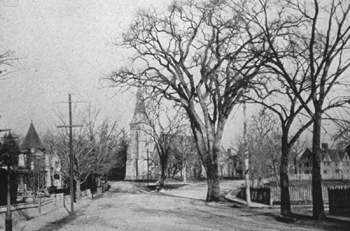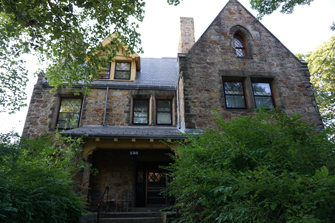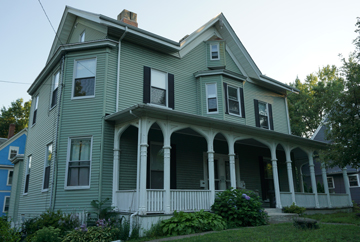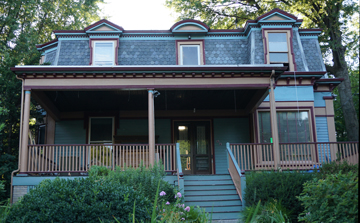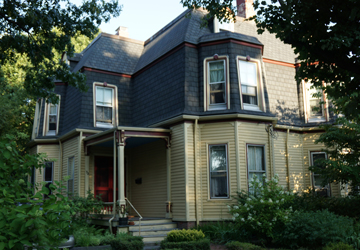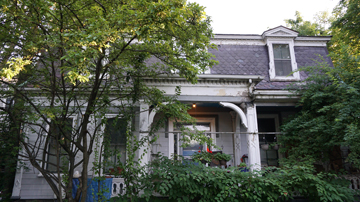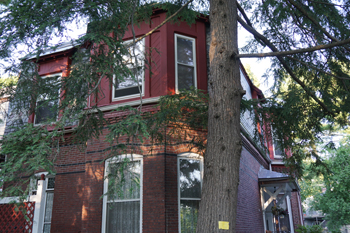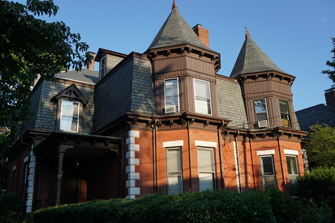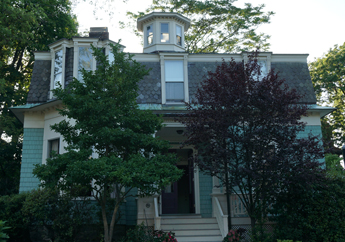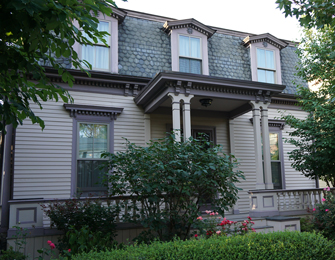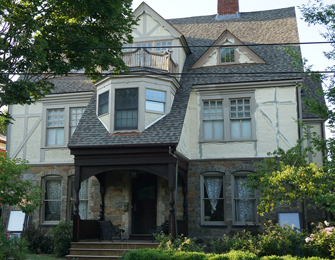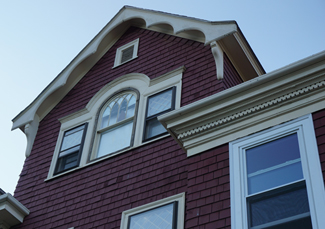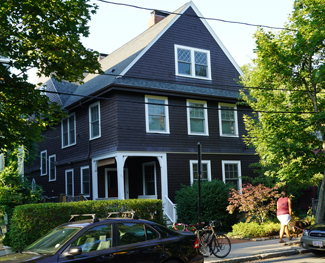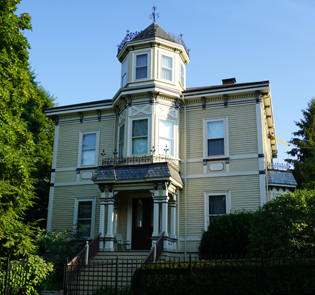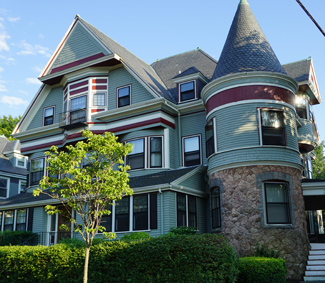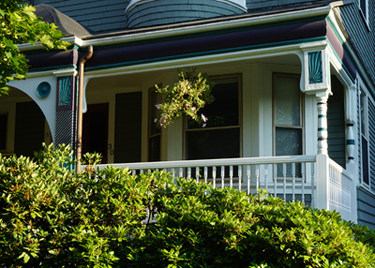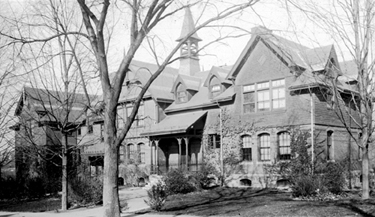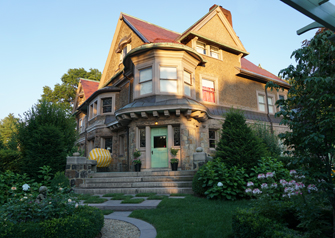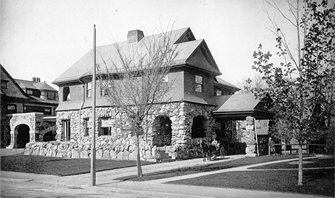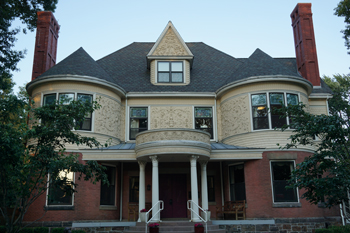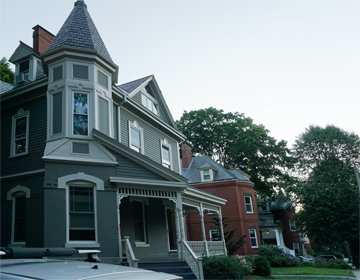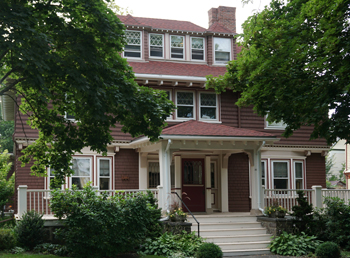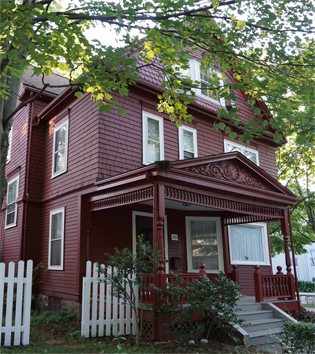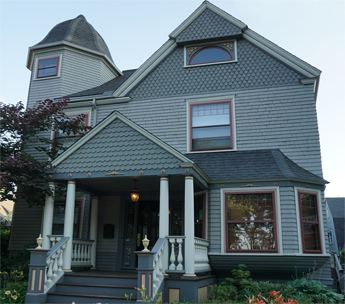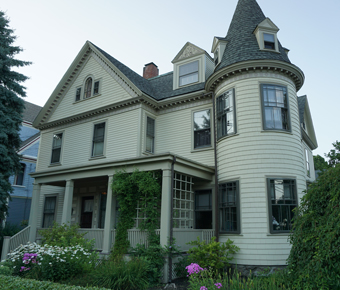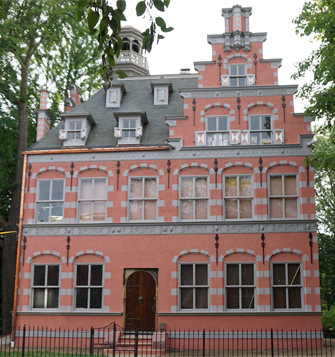- Print this tour map and follow its indexed locations on this page
- Follow this Google map tour
Through the mid-nineteenth century the Aspinwall property, extending roughly east-west from St. Paul Street to Brookline Avenue and north-south from Francis Street to Brook Street, remained largely undeveloped. What is now Aspinwall Avenue was a small lane running off Harvard Street to reach the Aspinwall house and another dwelling occupied by the Perry family. This narrow road which led toward the marshes (now the Longwood-Cottage Farm area) was frequently used by the Brookline residents for picnicking. At that time the village brook (where Brook Street is today) was surrounded by grassy meadows and groves of trees which made it particularly attractive for restful outings. However, the rural setting was not to last. The Aspinwall land was close to the commercial center of Brookline and development pressures were soon felt. Although never used, a subdivision plan for the Aspinwall property was prepared in 1852. Even at that time the land's development potential was realized. By the 1850s more streets had been opened, and the Aspinwall family was selling off land to various individuals. By the 1870s scattered dwellings had appeared along Aspinwall, Toxteth, Francis and Kent streets. [1] One of the earliest buildings in the area is St. Paul's Episcopal Church whose buildings and surroundings formed one of the region's most pleasant and picturesque bits of scenery. Burned in January 1976, only the shell of the sanctuary remains. Constructed in 1851-52, the Church was designed by Richard M. Upjohn, the well-known architect who had recently completed Trinity Church in New York City. August Aspinwall gave the corner lot and Harrison Fay, a resident of Linden Street, donated a substantial amount of money to ensure that a noteworthy monument was erected. Holding a commanding pivotal position at the corner of Aspinwall Avenue and St. Paul Street, the large Gothic edifice is constructed of Roxbury pudding stone and graced by a steeple whose bell was presented by T.C. Bell of London, a native of Brookline. The Gothic tradition is highlighted by the pointed, tri-partite arched windows with elaborate tracery, the false buttressing supports, the steep gable roofline, and the massive off-center spire.
[2] The Parish Hall, to the north of the main church, was built in 1896 after designs by J.A. Schweinfurth, an architect employed by Peabody and Stearns. [3] Farther down Aspinwall Avenue is St. Paul's Rectory which was built in 1885-86 in memory of Henry S. Chase. Mr. Chase, an early resident of the neighborhood, lived on the corner of Alton Place and St. Paul Street and operated a "bags and bagging business" in Boston. In the Jacobean style, the rectory is also constructed of Roxbury pudding stone. Earmarks of this style are the steep gable roofline, the prominent stone chimneys, the diamond panes in the upper sashes of the windows, and the pointed arched window in the front gable. Other pleasant decorative details are the sandstone quoining and lintels, the slate roof, and the scalloped barge-board on the front gable dormer. [4] Before turning onto Perry Street mention should be made of number 165, farther down on Aspinwall Avenue. Built between 1852-55 by a member of the Aspinwall family (probably William, but possibly Thomas), this house is the only remaining link with the former Aspinwall estate. Although most of the structure's original Gothic detailing has been lost, one can still appreciate the Gothic treatment of the porch and the finials in the front and side gables.
Perry Street, named after the Perry family who were original residents in the area, boasts a fine collection of Second Empire or Mansard style buildings. This style, popular in the 1860s and 1870s, was a direct importation from France. Napoleon III (1852-70) during his major building campaign in Paris brought back to popularity a roof form developed by seventeenth century French Renaissance architect Francois Mansart. The mansard roof, a double-pitched roof with a steep lower slope, became a hallmark of the style and was quickly adapted throughout Europe and America. By increasing the head room in the attic space, an additional useable floor was created. To furnish light for this area, the mansard roofline was usually pierced with dormers. Characteristic of the Second Empire style are prominent projections and receding surfaces, the use of classical pediments and dentilled cornices, the wide frieze boards, and the presence of entrance porticos and porches. Quoining and cupolas are also frequent decorative details. [5] The recently renovated house at 66 Perry Street is a showplace of the Mansard style. Built in 1871 for Daniel Worthley, the house was later owned by Mr. Charles W. Holtzer, the gentleman who founded the Holtzer-Cabot Electrical Company (see the Village Tour). Noteworthy features of the building include the original scalloped slate mansard roof, the label moldings above the windows, and the interplay of small and large brackets along the eaves and cornice. [6] Across the street at 71-73 Perry Street is another, though more simply detailed, clapboard mansard structure. A double house, the building is symmetrical in its arrangement as evidenced by the two-story projecting central bays and the end entrances. Interestingly the second floor mansard is surmounted by another mansard roofline on the third floor. Note also the circular decorative molding motif above the second floor windows. This same detail is used on 94 Perry Street farther down the street. [7] On the opposite side of the street (facing the alley) stands another mansard remarkably similar to 66 Perry Street. Once again there are the Second Empire hallmarks-the scalloped slate roof, the label window moldings, the bracketing (resembling dentils) details along the eaves and cornice line, the pedimented and round arched dormers, the projecting side bays, the wide friezes, and the corner pilasters. A Doric columned portico with arched wooden bracing frames the entrance. [8] In sharp contrast to these mansard cottages is 81 Perry Street. Although it has a mansard roof form, this house has readily identifiable overtones of the Stick style with its stick work on the second-story bays and the bracketing on the entrance hood. Also take note of the tar-dipped and corbelled brickwork as well as the multi-colored (polychromatic) slate roofing. [9] 85-87 Perry Street is another double mansard house. Although built approximately a decade later, this building has the same form as 71-73 Perry Street. However, this similarity is barely discernible due to the different stylistic interpretations. Whereas 71-73 Perry Street is the Second Empire style, this house intermixes Queen Anne and Stick style details with a mansard structure. Typical of the Queen Anne style are the towers with decorative finials which crown the projecting bays and the interplay of surface materials (i.e., red brick, slate, vertical boarding). Reminiscent of the Stick style is the hammer-beam on the steep gable dormers and the sawn-edge vertical boarding on dormers and bays. Finally one can see mansardic features in the quoining and heavy lintels. [10] The tower motif is evident on the building next door. Built at the turn of the century, the building was converted to condominiums in 1974. Flanked by three-story turrets, the edifice shows Colonial Revival influences in its symmetrical massing, the broken pediments over the second-story windows, and the dentils under the eaves and along the columned portico. Before leaving Perry Street, note the mansard cottage across the street with its scalloped slate roof capped by a cupola.
[11] Recalling number 71-73, Hone again notices the decorative circular molding motif. Francis Street presents an accumulation of architectural stylistic traditions.
[12] At 91 Francis Street the thread of mansards is continued with this pristine example of the Second Empire style, built in 1873.
[13] Directly to the left is 97 Francis, a massive stone house built in 1882 (as carved in the stucco central gable) for Henry S. Chase. In sharp juxtaposition to the delicate detailing of its Second Empire neighbor, this building resembles the Rectory on Aspinwall Avenue in its surfacing, steep gable roof, massive chimneys and fenestration. It should be recalled that the descendants of Mr. Chase financed the construction of the Rectory.
[14] Equally massive are the two buildings across the street. Built in the mid 1890s, 100 Francis Street is distinctively Queen Anne with its irregular rooflines and fenestration as well as its mixture of facade materials. Here color plays strongly in the highlighting of details- around the windows, the cornice, the turrets, gables, and the offset course. The copper finials, the Palladian window, and decorative mastic add even more to an already lively facade.
[15] Compare this with the more restrained treatment of the Georgian Revival building next door at 106 Francis Street. A symmetrical, four-square clapboard structure with light-colored facade and trim, one can sense the return to classical architecture. Rather than the light and free-flowing quality of 100 Francis, one senses the orderly scale and classical correctness. Take note of the swag motif over windows and along the frieze, the wide pilasters, and the balustraded portico and entrance porch.
[17] Before retracing one's steps down Francis Street, notice the eclectic cottage at the corner of St. Paul and Francis streets. Much altered through the years, the Swiss pierced detailing gives this late 1870s building a distinctive appeal.
[18] Returning down Francis Street, the two three-deckers on the left provide an interesting contrast. One sees how the architectural detailing has been retained on number 85-87. Keeping these architectural elements retains the building's original architectural integrity and echoes the historical past of this streetscape.
[19] Farther down Francis Street is a row of shingled buildings, all built in the mid 1890s.
[20] 67 Francis Street shows classical influences with the return cornice, dentils, and Palladian window in the gable. [21] The buildings at numbers 71 and 63 are more vernacular - simple in detailing and dominated by the shingled siding material. Whereas the emphasis of the Shingle style was upon the weathered shingles which enveloped the building surface, the earlier Italianate style stressed a more delicate articulation as in 54 Francis Street The most elaborate of Italianate houses had a low roof, overhanging eaves with decorative brackets, an entrance tower, round headed windows with hood moldings, quoining, arcaded porches and balustraded balconies. At its simplest, the typical Italianate structure was a square house with a low roof, bracketed eaves and perhaps a cupola or lantern. [22] The house at 54 Francis Street falls between these two extremes. Built in 1874-75 for James H. Standish, the building has an elegant columned entrance portico with slate roofing and metal cresting. Additionally, a polygonal bay rises above the roofline and is topped by an iron-crested turret. In striking contrast to its unadorned Shingle style neighbors, this rigidly vertical edifice has particularly handsome trim with its dentils, bracketing, paneling, and diagonal stick work under the windows. Do not overlook the Italianate carriage house which complements the main house in style and detailing. [23] Lower Francis Street is dominated by Queen Anne style buildings. Note particularly the irregularity of the roof shapes and fenestration on 34-36 Francis Street. This stylistic exuberance allowed not only an openness of interior spaces, but also the play of light and shadows along the exterior. [24] At 30 Francis Street one can see the textural surface richness typical of the Queen Anne style. The bulbous Jacobean turned supports on the front porch offer a striking detail. [25] The Lawrence School at 27 Francis Street was named for Amos A. Lawrence, the wealthy merchant and philanthropist who lived in Cottage Farm. First built in 1874 by Peabody and Stearns, the school was expanded in 1885 and 1891. In 1930 it was rebuilt in the neo-classical style with its traditional pedimented central gable and simple Doric columns. [26] On Kent Street, one will find some of Brookline's fine examples of the architectural eclecticism which was prevalent during the Victorian era. Along this street and the adjacent Longwood Avenue area, several of Brookline's wealthier citizens built homes during the last quarter of the nineteenth century. Here, yards are more spacious, landscaping is lush, and carriage houses are common. The Queen Anne Revival house at 269 Kent Street exemplifies these traits. Built in 1885 by the real estate magnate John Prescott Webber, the building holds a commanding position at the corner of Longwood and Kent which is further accentuated by its size and massing. The most important element of the structure is its surfacing material. Random and quarry-faced ashlar are used on the first floor while roughcast is used on the second level. One can feel the sheer "weight"-a heaviness created through the low slate roof, large brackets, the irregular but dominating fenestration, the massive bays, gables, and other decorative details. Note the terracotta plaque set into the ashlar facade and the feather-Renaissance motif on the second floor carvings. Both of these provide additional texture to an already richly decorated building. [27] Next door one can define influences of H.H. Richardson's architecture in the overbuilt masonry, the horizontal massing, and the offset course. [editor: 259 Kent]
[28] At 253 Kent Street observe the bell-cast hip and gable slate roofline. It appears that this house, built in the late 1870s or early 1880s, originally was a wooden frame building which was resurfaced with stucco during this century.
[29] Its neighbor at 247 Kent Street, however, has undergone few alterations. Built approximately the same time, the building has its original front doors and decorative incised bargeboard. Also unaltered is the tight Italianate profile with wide overhanging roofline, vertical thrust and elongated 2/2 windows. Stick style influences are evident in the vertical boarding under the windows, the cornice hoods, and the bands of horizontal stick work. While all the cornice caps have been removed from the front facade and some of the stick work has been taken down, one can see these features on the side-of the house. [30] Continuing down the road, the structure at 241 Kent Street shows the classical influences of early 1890 architecture. Chimneys are symmetrically located and the bays balance each other. Several details are worth noting - the elaborate wood panels on the second floor and gable dormers, the decorative looped treatment of the eaves, and the sunburst fan forms on the front doors. In spite of the decorative exuberance of the building's details, the form is basically box-like in contrast to its neighbors across the street
[31] at 232 and 240 Kent Street. Both of these buildings built in the early 1880s are good representatives of the Queen Anne style. Bays and porches "wrap" the building, thereby breaking down its edges. Similarly all doors, windows, porch banisters, and rooflines are highly articulated. This is particularly true at 240 Kent Street where the use of stark white color accentuates the trim.
[32] Contrast this highlighting of building parts with the non-articulation of elements in the "bungalow" house at 229 Kent Street. Horizontal in its massing with overhanging eaves, this building has little decorative ornamentation. Rather the building is classically ordered- a far cry from the unrestrained Queen Anne influences. [33] Walking down Kent Square one will undoubtedly be struck by the five Queen Anne houses on the left side of the street. Built for E.W.E. Tompson in the early 1890s, all are similar in shape and surfacing materials. Although variations give each house its own character, there are several predominating architectural motifs- the combination of shingling, brick, and clapboard materials; the presence of front bays capped by turrets; and the turned posts and balustrades on the front porches. Turning onto Harrison Street, one sees some duplex bungalows built in the 1920s, and several gable front two-family houses built a decade or so earlier. Symmetrical and often classically detailed, these houses reflect a vernacular simplicity in contrast to the buildings on Kent and Francis streets. No longer does one sense individualistic architectural extravagances. Instead, the houses are unassumingly functional, regular in fenestration, and box-like in form.
[34] Before returning to Aspinwall Avenue note 20 Harrison Street, a shingled house going "classical". Built in the mid 1890s, classical influences can be appreciated in the dentilled offset course, the elaborate entrance portico and doorway, and the building's regular massing. As one approaches the corner of Aspinwall and Harrison, it should be mentioned that William Aspinwall erected his hospitals nearby in 1778. The Town had initially refused to give him permission to use his house as a hospital for inoculating against smallpox. However, they eventually permitted him to build such "pest hospitals" on his own estate. One was erected on the left hand side of Aspinwall between Toxteth and the MBTA right-of-way. Another was located near the corner of Perry Street. Much has already been said about the textural richness of the later nineteenth century buildings. This can be particularly seen along this stretch of Aspinwall Avenue.
[35] On number 177, clapboard marks the first floor whereas a combination of regular and scalloped shingles are used on the upper floor.
[36] 179 Aspinwall, which is the same house form, is clapboard on both floors with shingles on the gables. [37-38] A third house, number 183 is enveloped with regularly shaped shingles whereas the final building 189 Aspinwall intermixes regular, jagged, and diamond shaped shingles to give further accentuation to the lines of the house. As one passes these houses, note the elaborate stained glass window on the side of number 179 as well as the classically refined window at number 183.
[39] Just as shingling materials are often repeated, the three houses across the street at numbers 198, 204, and 208 echo another pattern. Here the small square paned windows, typical of the Queen Anne style, are repetitive decorative details.
[40] Built in the early 1870s the mansard cottage at 203 Aspinwall was the first to be constructed on the upper portion of Aspinwall Avenue. Traces of the Stick style can be recognized in the hammer-beam in the gable window above the entrance as well as the vertical and horizontal boarding on the first floor. [41] Across the street at 212 Aspinwall Avenue note the half-timbered gables which are similar to the half-timbering at 97 Francis Street.
[42] Likewise the inlaid chimney design at 220 Aspinwall recalls comparable chimney work at 240 Kent Street.
[43] At 224 Aspinwall, one should not overlook the Queen Anne building with Colonial Revival details which are evident in the dentils, swag motif and Palladian window.
[44] Diagonally across the street at 233 Kent one sees how the swag motif and Palladian window is used once again on a building constructed years later in the Colonial Revival style. [45] The final house on the tour, the Dutch House at 20 Netherlands Road, is one of Brookline's most important structures. Mr. Charles B. Appleton (who incidentally lived at 207 Aspinwall) was captivated by the structure when he saw it at the 1893 Chicago World's Fair. Consequently, he had it dismantled and reconstructed in Brookline a year later with the intention that it become a museum or retreat for artists. The Boston architects Messrs. Kingsbury and Richardson were responsible for the construction while F.F. Mclntire of Salem had charge as the builder. Built in Holland and Belgium, the house was modeled after the sixteenth century Francker Town Hall in the Friesland province of Holland. With seventeen dormers, stepped gables and 12,000 leaded green-glass window panes, the 3h story building (now a private residence) is considered a masterpiece of High Renaissance Dutch architecture and unique in America.
© 2015 Brookline Historical Society
